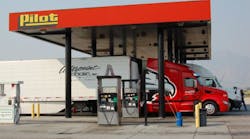With global oil prices at their lowest point in nearly 11 years, U.S. retail prices for diesel and gasoline continued to decrease this week and are projected to keep declining into the first quarter of 2016, according to data tracked by the Energy Information Administration (EIA).
The national average retail price for diesel dropped 5.4 cents this week to $2.284 per gallon, EIA said, which is 99.7 cents cheaper per gallon compared to the same week in 2014.
Diesel prices declined in every region of the U.S. the agency said, dipping the most in the Rocky Mountains; by some 7.1 cents to $2.304 per gallon.
The Gulf Coast is home for the cheapest diesel this week, at $2.181 per gallon (down 3.1 cents from last week), while California hosts the most expensive at $2.611 per gallon (down 3.9 cents from last week), the EIA noted.
The national average retail price for gasoline also declined this week, the agency added, albeit just barely; down one tenth of a penny to $2.026 per gallon, which is 37.7 cents cheaper per gallon compared to the same time period last year.
However, prices did tick up slightly in two regions of the U.S., according to EIA’s data. The Lower Atlantic witnessed a four-tenth of a penny hike to $1.962 per gallon, while the West Coast experienced a 5.6 cent jump to $2.570 per gallon (which morphed into a 1.2 cent hike to $2.283 per gallon with California’s prices removed from the mix).
Gasoline prices fell in every other region of the country this week, the agency added, with prices below the $2 per gallon mark in four areas: the Lower Atlantic ($1.962), the Midwest ($1.876), the Rocky Mountains ($1.994) and the Gulf Coast ($1.781, which is the cheapest regional price for gasoline in the U.S. this week, EIA noted).
The agency also expects retail prices for both diesel and gasoline to keep falling at least into the early part of next year.
According to its Short Term Energy Outlook (STEO) issued earlier this month, retail diesel fuel prices, which averaged $3.83 per gallon in 2014, are projected to finish 2015 at an average of $2.71 per gallon and then fall to an average of $2.67 per gallon in 2016.
Where retail gasoline prices are concerned, EIA expects them to average $2.04 per gallon in December 2015 and $2.14 per gallon in the first quarter of 2016.
Lower projected crude oil prices this winter are contributing to a reduction in residential heating oil prices, the agency said – and since heating oil is made from the same base stock as diesel fuel, that should help keep diesel prices down.
EIA said that households using heating oil are expected to pay an average of $2.40 per gallon this winter, which is 64 cents per gallon lower than last winter. As a result, the average household is now expected to spend $1,282 for heating oil this winter, $570 less than last winter, the agency noted.



